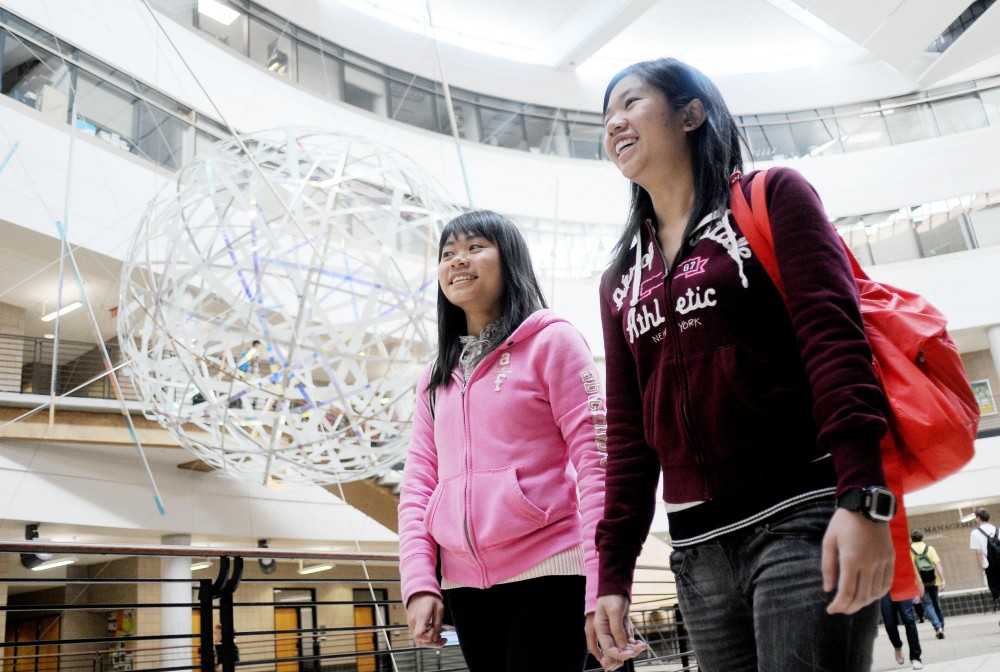For Ka Yee Ng and Ka Yan Tam, making friends with American students at the University of Minnesota isnâÄôt as easy as they originally thought it would be.
As the only two undergraduate exchange students from the Hong Kong University of Science and Technology this semester, they now study in the Carlson School of Management and will finish their exchange program in December. Then, they will go back to Hong Kong finished with college.
Deanne Silvera, an associate counselor with International Student and Scholar Services, said that the University sends about 50 to 60 exchange students every academic year through UniversityâÄìwide exchange programs, and another 150 exchange students per year through college-based exchange agreements.
She said that some of the current exchange partners are institutions in countries like Austria, Brazil, China, Denmark, France, Japan, Norway, South Korea, the United Kingdom and others.
The Learning Abroad Center has sent 54 students abroad 2010 and 2011 through an exchange agreement, said Sarah Tschida, an associate program director at the LAC, in an email. Currently, Norway receives the most University exchange students per year.
âÄúWe have seen growth in the number of students we send abroad through an exchange program over the past five years,âÄù Tschida said.
Exchange programs are popular in the Carlson School because all undergraduate students are required to have an international experience.
Kirsten Alexejun, a director for Carlson Global Institute, formerly International Programs, said in an email that the key to a successful exchange program is a balance between the number of inbound and outbound students.
âÄúIt may not be an exact match for every program every year, but overall, the number of inbound and outbound students is nearly equal,âÄù Alexejun said.
On average, the Carlson School sends about 100 students each year to its partner business schools around the world in Europe, Asia, Latin America and Oceania. They accept about the same number of exchange students in return.
Since the Carlson School sends and accepts the most exchange students, it works to find ways to help foreign exchange students transition to American culture.
Pomi Tefera, president of GLOBE âÄî a student group affiliated with the Carlson Global Institute âÄî said that the organization helps pair each incoming international exchange student with a Carlson School volunteer âÄúbuddyâÄù to ease the transition into American culture.
Tefera said the group plans events during Welcome Week before classes start and schedules fun trips throughout the semester to Minnesota Twins games, to the Capitol in St. Paul and social hours at nearby bars and restaurants.
Ng was paired with a buddy but said she didnâÄôt feel like it was very helpful.
âÄúMy buddy sent me an email earlier September, but then disappeared,âÄù Ng said. âÄúI did not meet my buddy yet.âÄù
Ng said she has found social events through the GLOBE Facebook page like a Halloween party for both Carlson School foreign exchange students and some American students.
Living in Middlebrook Hall with Tam, Ng said that she has not had many chances to make friends with local students.
âÄúIn the ISSS orientation for foreign exchange students, I learned that one cultural difference is that the relationships between people here [are more] short-term and shallow than âĦ in Hong Kong,âÄù she said. âÄúItâÄôs hard to build and maintain a deep and long-term relationship with local Americans, which is something we are used to and feel comfortable with in Hong Kong.âÄù
Ng said that most of her classmates leave immediately after class, which makes it even harder for her to get to know students.
Tefera said it is increasingly important for students to build relationships across different cultures.
âÄúIf I could advise anybody at the [University], it would be to plan ahead, leave your comfort zone, make it happen because it is an experience you will always treasure,âÄù she said.


